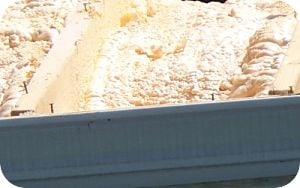Insulating our homes is essential for Central New York residents. With our very cold winters and hot summers, insulation is a sure way to save on energy costs.
One of the best products available is spray foam insulation. Spray Polyurethane Foam (SPF) can be used to fill spaces in walls, attics and floors to provide maximum insulation. When applied, it works its way into tight spaces, hardens and expands to about 100 times its initial volume to form an air-tight seal. It seals so efficiently that your home will be warm in the winter since heat can’t escape and cool in the summer as cool air is retained.
Fiberglass and other insulation products can’t compare with the way SPF performs in providing an air tight seal. SPF is more expensive than fiberglass insulation but is more efficient based on the U-value, which measures the transfer of heat through insulation. Even when fiberglass is installed properly it may have gaps and pockets that reduce the effectiveness of conserving energy. If the fiberglass insulation is not installed properly it can cause condensation, moisture build up, mold, and rot in ceilings and walls.
The advantages and benefits of SPF include:
-
Reduced energy costs
-
A more comfortable home interior environment
-
Reduced draft and noise
-
A barrier to keep bugs and other pests from entering your home
-
Seals to resist mold and mildew
-
Eligible for federal tax credits
-
It lasts a life time
Here are some facts you need to know about SPF:
-
Consult a professional contactor to install SPF. This is not a product to be installed by an amateur. If you’re considering using SPF in your home you may find articles or information online about doing it yourself. Don’t attempt it. The installation of SPF requires special equipment, the right mix of chemicals and knowledge of the product to assure that the appropriate thickness is applied. There are warnings regarding the installation of SPF issued by the U.S. Environmental Protection Agency (EPA) including health concerns due to the chemicals used in SPF, particularly isocyanates which can cause breathing problems.
-
Finding a contractor. You should look for a SPF contractor or weatherization specialist who has had appropriate training in SPF installation, insurance, a good reputation and references.
-
Ask your contractor to do an energy audit of your home. Before installing insulation you should have an energy audit of your home to help identify areas where the insulation will be beneficial. Your contractor should advise you about where to install the insulation, what to expect during the installation and safety precautions for the products installed.
-
The product requires time to cure so you may need to wait until you can re-enter your home. Only workers with protective equipment should be in the home when SPF is installed. Ask your contractor about the cure time of the product being used since the time will vary from product to product and when it will be safe to re-enter the home to avoid exposure to vapors.

